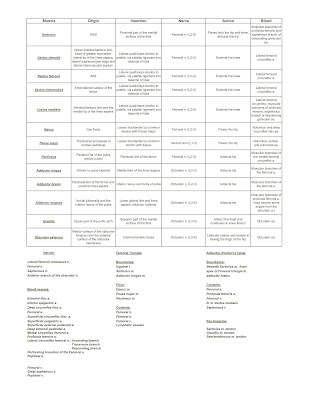Wednesday, May 26, 2010
Clarification on the dorsal scapular and transverse cervical aa.
Thursday, October 30, 2008
Wednesday, October 8, 2008
System for studying anatomy.
Due to a number of requests for some advice on studying techniques, I have prepared the following…
Anatomy is one of those subjects where you do, in fact, usually get out of the course what you put into it. Fortunately, this means that most students are quite capable of earning a high grade. Unfortunately, this means that what you have to put in is time – especially for a dissection course. If you dedicate yourself to doing well in the course, the time will be well spent.
Below is a study system that I (and many of my subsequent students) have successfully used for learning anatomy. It may give you some ideas on how you might study for this course:
First, read the lecture notes before the lecture.
I recommend that you prepare (read ahead) at least a couple lectures, because there will be lectures that will pertain directly to the dissections. For example, one week there may be a lecture on the muscles of the back and shoulder, which you could already be dissecting the week prior…
Additionally, each lecture will likely contain material that is conceptual in nature, and not simply identification. If you have not prepared in advance, this material may not be easy to grasp during lecture. As cliche as it is, "there is no substitute for good planning."
If the notes are in outline form, use them as such: understand the Objectives, and then look at how the notes are organized (read the Roman numerals, then capital letters). Only after you have done this, go back and read the “meat” of the notes. This will help you to understand the organization and pattern of the regional anatomy.
Secondly, do the supplemental reading (anatomy textbooks, atlases, etc.) for the lecture before the lecture (I recommend doing this immediately after reviewing the lecture notes).
Thirdly, read the lab notes, Grant’s Dissector and Moore & Dalley’s before the applicable lab day. If you don’t know what you are supposed to do each day (and have some idea how to do it), your dissections will go very slowly. If they are too slow, you will take more than your share of the allotted time, and hold up the other groups at your table. Your tablemates will not appreciate this, and it will be your fault.
Next, prepare “cheat sheets” for the labs, for every dissection (even the ones that you do not do). This should be done before the applicable dissection is started (if you are performing it; by the presentation otherwise). Or… if you feel that it’s too much work, arrange for the groups at your table to make up the sheets for their dissections, and have them bring hardcopies for everyone at your table no later that the lab before the applicable presentation. I highly recommend typed sheets for legibility (esp. if others do them for you).
The structures to be listed on the lab “cheat” sheets can be culled from a variety of sources, such as:
Lab notes
Lecture notes (see above)
Grant’s Dissector (every structure in boldface or italics)
Moore & Dalley’s
Netter’s flash cards
The muscle charts (origin/insertion/action/innervations/blood supply) are a useful study tool, since we are
responsible for that material. The info to complete them can be found in the sources above (esp. the last three
and online (see links at left).
Okay… the sample (below) is of my lab “cheat” sheets that I made for one of the Gross anatomy courses that I have taken. What I did was make up these… guides… that I used during my dissections (a list of what to find and make sure not to blow) and presentations (everything to point out). I create them in Excel (easier column creation and text justification), but use whatever you are comfortable with. I highly recommend that you organize your cheat sheets by dissection regions. Additionally, the muscle charts included on most cheat sheets include all muscles that are viewable in this region, not just those that are assigned to the specific dissection; review and global understanding is an important part of learning anatomy…
Next, learn the organizational patterns of anatomy within the regions. For example:
The common origins of muscle groups
Why structures are named as they are
How origins and insertions affect actions
Innervations of muscle groups
Muscular “compartments” (# of muscles included, common actions and/or innervations, etc.)
Mnemonics
Dermatomes and cutaneous nerve distributions
etc.
Second-to-last, fill in the specifics by memorization:
muscle charts
arterial/nervous system diagrams
lab “cheat” sheet structures contained within specific regions
"triangles,” "spaces," etc. (contents and borders)
Finally, review everything, OFTEN!!!!!!!!!!
Review lecture notes within one day of initially reading them, and again the day after that. Research shows that retention decreases dramatically after 24 hours from initial introduction, so reviewing two days in a row should really help you learn the material!
Use the Netter’s flash cards to test yourself during any available free time (e.g. in the 10 minutes before a class starts, during a meal break, etc.)
Review the material from the lab “cheat” sheets during open lab time, on as many cadavers as possible! As you cover each structure, mentally review everything that you have learned about it.
Attend as much “Open Lab” time as possible! The more time you spend reviewing anatomy, the more the material will stick. I also highly recommend that you spend open lab time reviewing cadavers other than your own! You have all your normal lab time to learn your cadaver’s anatomy, but you need to understand anatomical variation and how the same structures can appear different from one specimen to another. Remember, you will not be tested on just your cadaver, but all of them…
Find or form a study group. Testing (quizzing) each other is a great way to learn.
I’m sure that you noted that the key to studying anatomy is to prepare ahead of time. Unlike most undergrad work, you will have to teach yourself most of the material, so be prepared to invest the time and effort necessary to learn the material. When taking Gross anatomy courses, I have spent 2-4 hours studying during the weekdays and an entire day on the weekend (8 hours or so). Obviously, this system takes a lot of time, so you may well want to figure out what works for you…
Good luck!
Mnemonic for retroperitoneal organs.
Under-----Ureter
Swings----Suprarenal Gland
Are--------Aorta
In----------Inferior Vena Cava
Severe----Sympathetic trunk
Pain-------Pancreas (except tail)
And-------Ascending Colon
Deep------Descending Colon
Danger----Duodenum (segments 2 & 3)




